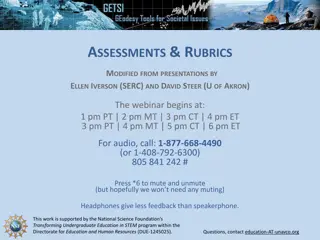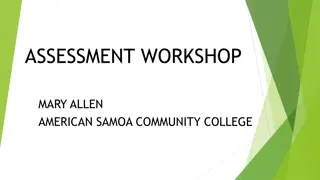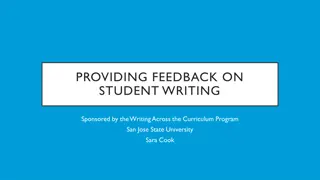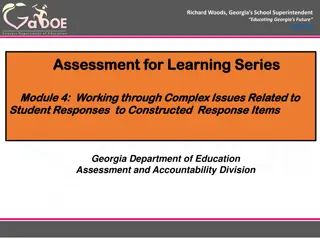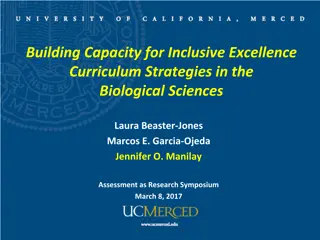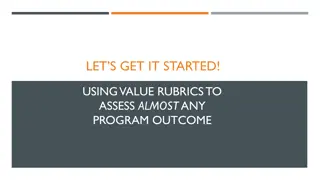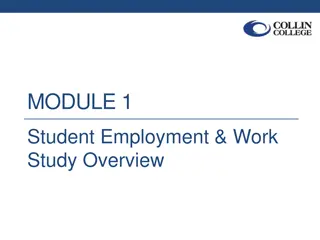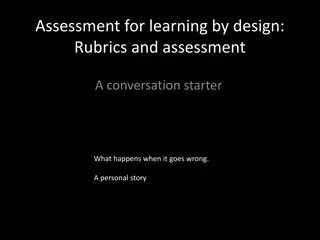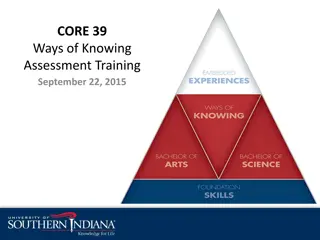Effective Rubrics for Assessing Student Work
Crafting and utilizing rubrics is essential in evaluating student assignments. A well-structured rubric outlines criteria and quality levels, aiding in providing personalized feedback efficiently. Learn about writing rubrics, motivations for using them, and the process of creating effective assessment tools.
Download Presentation

Please find below an Image/Link to download the presentation.
The content on the website is provided AS IS for your information and personal use only. It may not be sold, licensed, or shared on other websites without obtaining consent from the author.If you encounter any issues during the download, it is possible that the publisher has removed the file from their server.
You are allowed to download the files provided on this website for personal or commercial use, subject to the condition that they are used lawfully. All files are the property of their respective owners.
The content on the website is provided AS IS for your information and personal use only. It may not be sold, licensed, or shared on other websites without obtaining consent from the author.
E N D
Presentation Transcript
Teaching Excellence Initiative Marking Rubrics Sarah Honeychurch Teaching Fellow Adam Smith Business School Sarah.Honeychurch@Glasgow.ac.uk
What is a rubric? A rubric is an assessment tool that lists the criteria for a piece of work or what counts (for example, purpose, organization, details, voice, and mechanics often are what count in a written essay) and articulates gradations of quality for each criterion, from excellent to poor. (Andrade 2005) Criteria Definitions Grading strategy (Dawson 2017)
Teacher and learner motivations Why are you using a rubric? Teacher marking Teacher feedback A good rubric allows me to provide individualized, constructive critique in a manageable time frame. (Andrade 2005) Understanding a task Self assessment Peer assessment Using to teach
Writing rubrics: process 1. Look at models of previous student work 2. Look at course ILOs 3. List criteria 4. Pack and unpack criteria 5. Articulate levels of quality 6. Create a draft 7. Test the draft 8. Hand out the rubric with the assignment Develop an exercise for students to co-create a rubric in class Develop a peer review/self assessment exercise using a rubric
Biggs: SOLO The SOLO taxonomy classifies understanding into five levels: Prestructural: at this level the learner is missing the point Unistructural: a response based on a single point. Multistructural: a response with multiple unrelated points. Relational: points presented in a logically related answer. Extended abstract: demonstrating an abstract and deep understanding through unexpected extension.
References Heidi Goodrich Andrade (2000) Using Rubrics to Promote Thinking and Learning Educational Readership 57:5 13-18 Heidi Goodrich Andrade (2005) Teaching With Rubrics: The Good, the Bad, and the Ugly, College Teaching, 53:1, 27-31, DOI: 10.3200/CTCH.53.1.27-31 Phillip Dawson (2017) Assessment rubrics: towards clearer and more replicable design, research and practice, Assessment & Evaluation in Higher Education, 4 2:3, 347-360, DOI: 10.1080/02602938.2015.1111294 Anastasiya A. Lipnevich, Leigh N. McCallen, Katharine Pace Miles and Jeffrey K. Smith (2014) Mind the gap! Students' use of exemplars and detailed rubrics as formative assessment. Instructional Science 42:4 539-559 https://www.jstor.org/stable/43575435 Y. Malini Reddy & Heidi Andrade (2010) A review of rubric use in higher education, Assessment & Evaluation in Higher Education, 35:4, 435-448, DOI: 10.1080/02602930902862859
Teaching Excellence Initiative Marking Rubrics Sarah Honeychurch Teaching Fellow Adam Smith Business School Sarah.Honeychurch@Glasgow.ac.uk
Principles of Assessment and Feedback Good assessment and feedback practice that promotes self-regulation requires that students gain practice in: 1. formulating goals for learning and identifying standards 2. making evaluative decisions about their own and others' work 3. generating explicit feedback for self and others 4. responding to and/or acting on feedback 5. discussing work and its evaluation with others (e.g. with peers and teachers)


